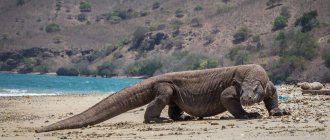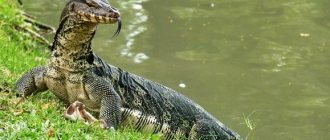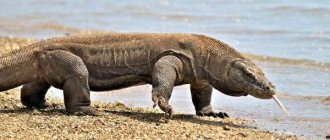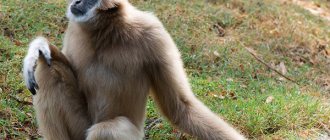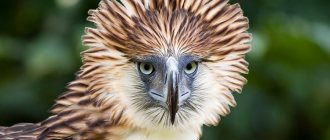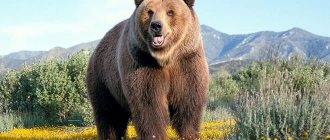15 December3695reptiles or reptilespredator dangerousendemic
The Komodo dragon is the largest lizard on our planet. It is also called the Komodo dragon. And it’s not in vain that its harsh disposition, gigantic size and poison make it a top predator and extremely dangerous not only for any animal, but also for humans. In this article you will learn the peculiarities of life and interesting facts about the Komodo dragon .
Geographical range
Although Indonesia consists of more than 17,000 islands, only five of them (Komodo, Rinca, Flores, Gili Motang, Padar - islands belonging to the Sunda Islands archipelago) can be found Komodo dragon. This reptile has the smallest natural range of any large predator.
Photo: USO/iStock
approximately 5,000 individuals across all five islands , making the Komodo dragon a critically endangered species. On Komodo, the island with the largest number of monitor lizards, a national park has been created to protect the endangered powerful lizards.
Interesting Facts
- Komodo dragons have powerful immunity against many bacteria. In 2022, a protein compound with antibacterial properties was isolated from the blood of an animal. A substance of similar composition, synthesized in the laboratory, turned out to be effective against many drug-resistant bacteria and fungi.
- Large monitor lizards feed on carrion. There are known cases when large lizards dug up corpses in cemeteries and ate them. In this regard, in the habitats of giant reptiles, areas with dense soil are used for burying the dead, and heavy stones or concrete slabs are laid on top of the graves.
- In Central and South America, as well as on the Galapagos Islands, teiids, similar to monitor lizards in appearance and behavior, live. The American monitor lizard family (tegus, caiman lizards, ameivas) is not related to the South Asian and Australian species. Their appearance is a consequence of convergent evolution.
- The skin of giant monitor lizards is quite durable and suitable for processing. Shoes, bags, and belts are made from it. In some countries in Asia and Oceania, lizard meat and eggs are used for food.
Natural habitat
The ability to get to know these animals better is limited by the conditions in which they live. Komodo dragons inhabit arid and uninhabited volcanic islands with rugged, hilly terrain. These islands contain many different ecosystems, from grasslands and savannas to dense forests. In their native range, Komodo dragons remain at lower altitudes, avoiding high-altitude forests.
- Habitat: tropical
- Terrestrial biomes : savanna, forest, hill, grassland
Character traits
Appearance
One look at the giant Indonesian monitor lizard is enough to understand why it is called a dragon. This lizard has a large, wide, flattened head, a strong, thick neck, a long “cylindrical” body, widely spaced limbs and a powerful long tail, thick at the base and tapering towards the end. The length of the laterally flattened tail is equal to half the length of the monitor lizard’s body.
Photo: Terry Gosliner
These reptiles have a dull green-brown body and a yellow forked tongue. The lizard's entire body is covered with spherical scales, which act like chain mail . If you look closely at the scales, you can see osteoderms with spines, which are small bony protrusions. The scales are very resistant to injury, which is an important aspect when fighting for food or a mate. In addition, there are more adult males on Komodo than females.
The gait of the Komodo dragon is very peculiar, its limbs extend far from the body and sway from side to side when moving. Although the lizard appears to be slow, it can reach speeds of up to 21 km/h when chasing prey.
But the most powerful weapon of the Komodo dragon is six dozen sharp and strong teeth and... saliva. Since this lizard feeds on carrion, its saliva is full of all kinds of bacteria that are dangerous to health and life - just like a Tyrannosaurus rex. However, scientists are increasingly inclined to believe that under the monitor lizard's jaw there are poisonous glands that secrete a dangerous poison that causes slow death. When exposed to Komodo dragon saliva (or venom), blood pressure and blood clotting are reduced. The victim becomes unconscious, bleeds out, or dies from infected wounds.
Dimensions
The Komodo dragon is a large species of reptile. Males reach an average length of 2.59 meters, females are smaller, averaging 2.29 meters in length. In the wild, the reptile's weight reaches 90 kg. However, there were also individuals with greater mass – up to 160 kg. But fewer and fewer such specimens are being discovered, likely due to the decline in the amount of large game that the giant Indonesian monitor lizard preys on.
- Sexual dimorphism : male is larger
- Body length: 2.2-3.13 meters
- Tail length: 110-156 cm
- Body weight : 68-91 kg
Perception of the surrounding world
The Komodo dragon relies most on its sense of smell and taste. It sees well at a distance of up to 300 meters , but only in good lighting. This is due to the absence of rods (they only have cones) on the retina of the eye. But the giant monitor lizard’s hearing is poor - it can hear sounds with a frequency of 400 to 2000 Hz.
The monitor lizard senses food with its nose and tongue. The cut tip of the tongue traps food particles in the air and soil. From there they enter the sense organ located in the sky.
Color
The gray monitor lizard is a large creature. The maximum length of its body can reach one and a half meters. And the body, by the way, takes up only a third. The remaining length is “occupied” by the tail. The maximum weight can reach 3.5 kg. But such cases are rare. Males, as is usually the case in the animal world, are larger than females. However, not harder.
The gray monitor lizard, the photo of which is provided above, has a very interesting color. Although, judging by the name, it doesn’t seem so. In fact, it appears more sandy or light brown than grey. There were also numerous dark spots and specks with which the upper part of the body of these creatures was “strewn”. The neck is characterized by 2-3 longitudinal dark stripes, which connect at the back and seem to form a horseshoe-shaped pattern.
It is interesting that in “youth” the gray monitor lizard always looks brighter than in older age. The general background of young individuals has a yellow tint, and the dark stripes appear not brown, but almost black.
Eating habits
The giant Indonesian monitor lizard is a carnivore known for its insatiable appetite . He was often seen engaging in cannibalism. Adult Komodo dragons are the biggest threat to juveniles. Up to 10% of their diet consists of immature relatives.
However, the Komodo dragon is not lazy - it is capable of tracking down prey 10 times larger than itself. It will readily pursue large mammals (water buffalo, wild boar, horses, deer).
Photo: Mi. Sha
When monitor lizards find small prey, they attack it in the throat area, and they first try to knock down large prey. This once again proves their enormous - dragon - power. A strong tail is a good “helper” when attacking a large animal. This is a deadly weapon with a force of 2 tons.
The monitor lizard's favorite prey is the maned sambar. These deer are fast and cautious creatures that can only be caught by a skilled predator . Komodo dragons lie quietly along the paths and wait for the deer to pass close enough to catch him. There won't be much left of a captured animal - the Komodo dragon will even swallow hooves, bones and skin.
How dangerous are Komodo dragons?
Komodo dragons are dangerous to humans. Their size, sharp teeth and claws, and aggressive behavior can have lethal consequences even for an adult man. But despite all this, Komodo dragons do not regard humans as victims, only children. A Komodo dragon can attack an adult in times of hunger when there is a lack of food. An attack can be triggered by a person’s fresh wound, scratches, or recent surgery. These predators have an excellent sense of smell and, even with bandages applied, they can easily smell blood.
The islands where Komodo dragons live are not heavily populated by people. However, there are still settlements there, the number of which is steadily growing. In these regions, people often engage in agriculture, fishing, and animal husbandry. Because of the smell of fish or livestock, lizards enter villages, especially in hungry years. This leads to cases where the Komodo dragon kills a person.
It is still difficult for a Komodo dragon to kill an adult on the spot. The most common deaths are from blood loss due to wounds and medical care not provided in a timely manner. It is not uncommon for Komodo dragons to dig up fresh human graves in order to profit from dead bodies.
The Komodo dragon should never be domesticated or kept as a pet. This is a large and dangerous animal that cannot be trained and can eat its owner at any opportunity. The Komodo dragon can be kept in zoos, in specially designated and reinforced enclosures.
Lifestyle and behavior
Photo: Scott Wyden Kivowitz
The monitor lizard is most active during the day, and at night it rests in its hole, which it dug itself, or in another hidden place. It lives alone, but can hunt with other Komodo dragons. However, he must be alert, because conflicts and fights easily arise between hunters.
According to the hierarchy, the largest individual of the group begins the feast. However, young males often challenge adult companions for food and for females, that is, for dominance in the broad sense of the word. Frequent clashes between monitor lizards are evidenced by the large number of scars on their bodies. To scare the rival away from the female, the male gives a warning but painful strike to the opponent with his long tail. If he doesn't retreat, the real battle begins.
The giant Indonesian monitor lizard is one of the most intelligent creatures. He remembers well and learns quickly. Having once fallen into a trap, the Komodo dragon, the second time it comes across a cage with carrion attached inside, will be much more careful. Therefore, it is difficult to catch a monitor lizard for research.
Captivity
Monitor lizards are one of the few reptiles suitable for home keeping. When purchasing and arranging a terrarium, it is necessary to take into account the size of the animal and whether it belongs to a steppe, arboreal or aquatic species.
Thus, the length of the terrarium should exceed the length of the reptile by at least one and a half times, while for desert species it is worth purchasing horizontal models, for aquatic species - cubic, and for arboreal species - vertical. Driftwood and stones are placed inside, and sand or fine gravel is used as soil.
Under natural conditions, most species live in natural areas with a warm climate, so the temperature in the terrarium should be maintained at 28-30 degrees.
Young reptiles are fed daily, from 6-7 months they begin to give food every other day, and at the age of 1.5 years the number of feedings is reduced to 2 times a week.
The most suitable for keeping in captivity are the spiny-tailed, blue-tailed, emerald, Timorese, Cape and other species of small monitor lizards.
GIRAFFE
Breeding season
The mating season lasts from May to August. During the breeding season, males fight over territory and females, testing the air with their long forked tongue to stalk nearby females. This is called the "vomeronasal sensation."
Photo: Pinterest
During a fight, males stand on their hind legs and fight; the winner must pin his opponent to the ground. After winning, the male will try to approach the female. One of the elements of the many-hour “mating dance” is the male scratching and biting the female. At this time, the male protects his partner, driving away other rivals. Komodo dragons are also known to form pair bonds and even remain monogamous with their partner, which is rare among lizards.
- Breeding interval: once a year
- Breeding season: May to August
- Average age of sexual or reproductive maturity : 9 years (females), 10 years (males)
Cubs development
Photo: Chattanooga Zoo
In September, females lay eggs in nests they have dug. This is also where the intelligence of the Komodo dragon comes into play. Females often dig so-called fake nests , perhaps to confuse wild boars who like to feast on goat eggs. The female lays about 20 eggs the size of a grapefruit (about 12 cm in diameter). The young hatch after about 7-8 months. During this time, the mother regularly visits her nest to protect the eggs from other animals.
At birth, a young monitor lizard is approximately 30 cm long. After leaving the nest, it must take care of itself. The adults pose the greatest threat to the young, so they spend their early years in the trees, feeding on small mammals, lizards, insects and bird eggs. After about 6 years, the Komodo dragon grows up to two meters in length.
Photo: brentwhite1213
It has been discovered that female Indonesian giant monitor lizards can reproduce through parthenogenesis (immaculate conception) . This means that babies are formed only from the egg, without the “help” of sperm. This is a rare occurrence among reptiles. However, this is not a very positive phenomenon, since it ultimately reduces the genetic diversity among monitor lizards.
- Average clutch size: 18-20 eggs
- Incubation period: 7-8 months
How do they reproduce?
The breeding season of monitor lizards coincides with the beginning of the rainy season. Different species can have from 10 to 60-70 eggs in one clutch. Before laying eggs, the female digs a hole in wet sand or looks for a suitable place: an abandoned hole, hollow or termite mound.
The incubation period lasts 9-10 months. Females do not return to lay eggs and do not take care of their offspring. The cubs that are born are completely independent. At first, they are forced to hide in trees or in crevices between stones, so as not to become prey to natural enemies and larger relatives.
Some species of monitor lizards have the ability to parthenogenesis: females do not need prior mating with males to lay fertilized eggs.
FROG
Save Status
This species is classified as vulnerable by the IUCN. There are about 5,000 individuals (about 3,200 in the wild). Giant Indonesian monitor lizards are endangered due to:
- habitat loss;
- human incursions into their home range;
- overhunting by humans of deer, which is their preferred prey.
They are also threatened by volcanic activity on the islands, which can quickly kill many Komodo dragons while destroying their nests. Therefore, giant monitor lizards are now protected by Indonesian law, and Komodo Island has been declared a national park.
Where do they live?
The habitat of most modern species of monitor lizards is Australia, as well as the islands and archipelagos of Oceania. Reptiles live on the Arabian Peninsula, Central and South Asia.
Monitor lizards are also common throughout almost the entire African continent, but are not represented in the Madagascar fauna. It was this fact that served as the basis for the theory of the Asian origin of the family.
Where live
The natural habitat of monitor lizards is the tropics. The exception is the desert monitor lizard, the northern part of its range is in a temperate climate.
All types of monitor lizards are divided into three groups:
- desert ones live in arid regions with sparse bushes, savannas and woodlands;
- aquatic animals, which resemble amphibians in their lifestyle, spend most of their time in water, so they settle near ponds and swamps;
- arboreals live in dense tropical forests, climbing tree branches.
Monitor lizards are important in habitat ecosystems: they control rodent and insect populations and provide food for many species of birds and mammals.
Did you know?
- Komodo dragons live up to 50 years (average 30 years).
- The giant Indonesian monitor lizard is at the top of the food chain - it has no natural enemies.
- The Komodo dragon can sense food at a distance of 10 km.
- These lizards were first discovered by the Western world in 1910.
- On the islands, Komodo dragons often die of starvation due to massive poaching of large game.
- Contrary to popular belief, the giant monitor lizard does not attack people purposefully; it is easy to drive it away by throwing stones at it. Their attacks are rare, and deadly encounters are even rarer. In 40 years, only 24 attacks were recorded, and only 5 of them were fatal.
- A giant Indonesian monitor lizard can dig up a human corpse to eat it. On the islands where these reptiles live, concrete tombs are built to prevent such incidents.
- In the morning, lizards bask in the sun. Only after taking a sun “bath” is the Komodo dragon ready to hunt.
- Komodo dragons can swallow prey as large as a goat or small deer whole; After such a large meal, they slowly digest it and then regurgitate fur, horns and bones.
- Monitor lizards cannot be tamed in any way. They are potentially dangerous and can cause fatal injuries even to experienced and skilled trainers.
Arizona snaketooth
The Arizona common lizard (Heloderma suspectum) is one of two species of venomous lizards in the world, native to the Chihuahuan, Mojave, and Sonoran deserts of northwestern Mexico and the southwestern United States. These lizards are dark brown in color with spots of yellow, orange, and pink. The body length of an adult can be 50-60 cm. The vest has an extremely painful and poisonous bite that can kill a person. The Arizona hawksbill spends 95% of its life in underground burrows and emerges only to find food and bask in the sun. The lizard has a large reserve of fat in its thick tail, which allows it to survive for several weeks without eating.
